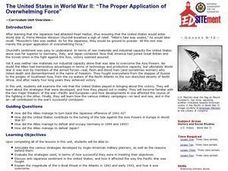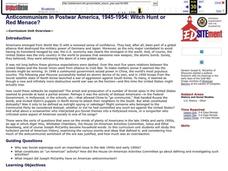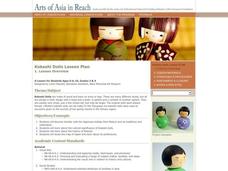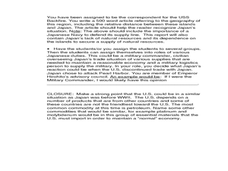Curated OER
The Art and History of Japanese Calligraphy
Chinese and Japanese calligraphy is beautiful and significant in both culture and tradition. Engage your class in this expressive fine art form through a lesson on using, holding, and creating brush strokes common to Japanese writing...
Curated OER
Textbook Changes in Japan
Students recognize that the Japanese government has made attempts to alter history textbooks to make it look like the military did not play a major role in the mass suicides during the American invasion in 1945. They review vocabulary,...
Curated OER
A Visit to Japan
Studnets complete a variety of activities as they develop an awareness and appreciation of Japanese culture: geography, food, homes, holidays, celebrations, education, games, etc.
Japan Society
The Bubble Economy and the Lost Decade
Explore Japanese society and national identity. Class members share ideas about the Japanese economy and then investigate a series of resources, including an article, a film, a lecture, and a poem, to learn about Japan's Bubble Economy...
Curated OER
What's In a Name?
Students explore the relationship between names and certain cultures and locations. In this identity lesson, students create family migration or immigration maps. Students read excerpts from When My Name was Keoko and Lost Names: Scenes...
Curated OER
Victory in the Pacific, 1943-1945
Students examine the military campaigns of the Pacific theater, tracing the path of the Allied offensives. The lesson presents what the Allies were trying to accomplish and why.
Curated OER
"The Proper Application of Overwhelming Force": The United States in World War II
Students examine the role that the U.S. played in bringing about victory in the two major theaters of the war in the Pacific and Europe. How the various military campaigns contributed to the war's successful conclusion forms the focus of...
Curated OER
Witch Hunt or Red Menace? Anticommunism in Postwar America, 1945-1954
Students investigate what constitutes an "un-American" activity and why Soviet espionage was such an important issue in the 1940's and 1950's. Joseph McCarthy's impact on American anticommunism is examined in this lesson. There are three...
Rutgers University
How the Allies Won World War II: Island-hopping in the Central Pacific
Using primary source documents, young historians explore the strategies the US used to defeat Japan during WWII. They also learn about the American military experience, and innovations that changed the style of warfare. Young scholars...
Montana State University
One Mountain, Many Cultures
Americans may think of Mount Everest as a region dedicated to adventurous hikers, but many cultures have flourished there! Learners read informative books, watch videos, participate in classroom discussion, analyze folk tales, and...
Curated OER
Japan: Yesterday and Today
Students study the geography and culture of Japan and discover important historical events. They look at the religions of Japan. They determine similarities and differences in the lives of teenagers in Japan and the US. They read and...
Curated OER
Social and Cultural Scene
Ninth graders examine the Imperial Era of Japan. In this World History lesson, 9th graders address the social and cultural aspects or history. students are given various true incidents and should understand that personal stories improve...
Curated OER
Examining Gandhi’s Critique of Modern Civilization: The Lessons of Modern Japan
High schoolers examine the political philosophies of Mohandas Gandhi. In this Mohandas Gandhi lesson, students investigate Gandhi's thoughts about modern civilization as they listen to a lecture presented by their instructor.
Curated OER
International Festival: Japan
Students create representative Sakura trees. In this multi-cultural appreciation lesson, students listen to their teacher talk about Japan before students create Sakura trees out of cotton balls and popsicle sticks.
Curated OER
Multimedia Lesson on Japan and Paper Cranes
Students explore paper cranes. For this Japan and paper cranes lesson, students discuss Japanese culture and history prior to creating their own paper cranes.
Curated OER
Lesson Plan On Japan
Learners participate in a lesson about the Japanese religion of Shinto. This is done using internet research where students compare this to other world religions in the context of the four basic Shinto beliefs.
Curated OER
Go Fly a Kite!
Students study kites. In this social studies activity, students discover the history of kites and what kites are made of. Students create their own kites to fly.
Curated OER
Peace
Ninth graders explore through research changes in Japan following A-bomb, discuss how people of all ages can model tolerance and peaceful coexistence, examine Constitution of Japan, and identify its three basic tenants.
Curated OER
Women in Society
Students survey similarities and differences in the role of women in Japanese and American culture and how these roles have changed over time. They predict what roles for women in Japan might have in the future and identify the...
Curated OER
The failure of Diplomacy, September-December 1941
Students investigate four main issues of concern between US and Japan prior to US involvement in World War II. In this role play lesson, students will take the role of US and Japanese negotiators trying to find a diplomatic solution to...
Curated OER
Burr Airlines Flight to Asia: Building Inquiry Skills
What a wonderful way to explore this topic! Learners take an imaginary trip to Asia, take a visual tour, and formulate questions for a research project. As a final project, they create a travel brochure.
Curated OER
Kokeshi Dolls
Students study the Japanese holiday Hina Matsuri and its traditions and celebration. They explore the history, location and cultural significance of Kokeshi dolls.
Curated OER
Pre-WWII Pacific W/Japan
Eleventh graders explain how the islands/countries contributed to Japan's war effort. They study the concept of location and determine how natural resources were a large factor in Japan's trade.
Curated OER
Religion in Japan
Students engage in a lesson that has them investigate the major religions of Japan. The primary concern of the research is for students to search for the true meaning of tolerance.

























